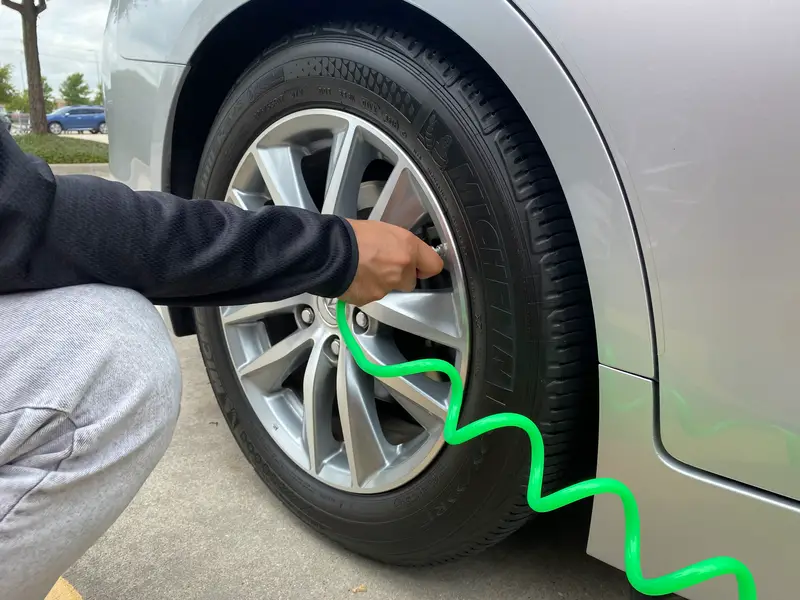Have you ever pulled up to a gas station with a slightly flat tire, only to discover that you need to feed quarters into a machine just to get some air? It seems strange that something as basic as air—which is literally all around us—comes with a price tag at many gas stations. Whether you’re scrambling for change or swiping your card for $1.50, it’s easy to feel annoyed. After all, shouldn’t air be free? As it turns out, there’s more to the story than gas stations simply trying to nickel and dime us.
The hidden costs behind air compressors
That air compressor sitting at the edge of the gas station lot isn’t just magically working day after day without any expense. Running and maintaining these machines costs gas station owners anywhere from $500 to $5,000 every year. Think about it—the compressor uses electricity every time someone fills their tires. Plus, the equipment itself wears down from constant use and exposure to weather. Parts break, hoses crack, and nozzles get damaged, especially when people aren’t gentle with the equipment (we’ve all seen that person dragging the air hose across the concrete).
Beyond the basic maintenance, gas station owners also have to pay for liability insurance related to these machines. What happens if someone gets hurt using the air compressor? Or if a tire explodes while being filled? The station could be held responsible. When you add up all these expenses, that $1 or $2 charge starts to make more sense. The fee isn’t meant to be a major money-maker for the station—it simply helps them recover some of the costs of providing the service in the first place. Without charging, many stations might decide it’s not worth offering air at all.
Why some states require free air
Did you know that in some states, charging for air at gas stations is actually against the law? California and Connecticut have laws on the books requiring gas stations to provide free air to customers who purchase fuel. This might explain why you’ve had different experiences depending on where you live or travel. These laws were put in place because lawmakers recognized the safety benefits of properly inflated tires—they help prevent accidents, improve fuel efficiency, and extend the life of your tires. By making air free, these states are encouraging drivers to keep their tires properly inflated, which is better for everyone on the road.
The catch? Even in these states, you might still see coin-operated air machines at gas stations. That’s because many people don’t know about the law and will pay without questioning it. If you’re in California or Connecticut and see a pay machine, just go inside and ask the cashier to turn it on for you—they’re required to do so if you’ve purchased gas. Some stations have a special trick to operating the machine without paying, but you’ll need to ask the attendant about it. This little-known fact could save you a couple of dollars on your next fill-up in these states.
The difference between chain and independent stations
Have you noticed that some gas station chains always seem to offer free air while others always charge? This isn’t a coincidence. The ownership structure of a gas station plays a big role in whether you’ll be paying for air or not. Company-owned gas stations, especially larger chains like QuikTrip, Royal Farms, Rutter’s, Sheetz, and Wawa, often provide free air as a customer service perk. These big chains can afford to absorb the costs of maintaining air compressors across hundreds of locations because they make their money from getting you inside the store to buy snacks, drinks, and other high-margin items.
Independent gas stations, on the other hand, typically operate on much thinner profit margins. These smaller businesses often can’t afford to offer free services without directly recouping the costs. Another common scenario is that gas stations contract with outside companies to provide and maintain the air machines on their property. These third-party companies install the machines at their own expense and make their money by charging customers directly. The gas station might get a small cut of the profits but has little say in whether the service is free or not. Next time you’re annoyed about paying for air, check if you’re at an independent station—they’re not trying to rip you off, they’re just trying to stay in business.
Finding free air near you
Fed up with paying for air? You’re not alone, and there are ways to avoid it. Many savvy drivers know where to find free air in their local area. Some rest areas in states like Florida have installed free air compressors for public use. Certain tire shops and auto parts stores also offer free air as a way to attract customers who might eventually need new tires or other car parts. Websites and apps like FreeAirPump.com have even sprung up to help drivers find gas stations with free air pumps in their area. These user-generated databases can be a lifesaver when you’re in unfamiliar territory with a low tire.
Your membership connections might also help you score free air. Places where you’re already a member, like Costco or Sam’s Club, often provide free air for tires that were purchased there. Some dealerships offer free tire services under warranty or as part of their customer service package. Even your roadside assistance plan might cover tire inflation if you’re stuck somewhere. The key is knowing what resources are available to you before you need them. Take a few minutes to check which places in your regular driving area offer free air—it could save you both money and hassle the next time you need to top off your tires.
How to save money with a portable compressor
If you find yourself needing to put air in your tires frequently, it might be time to invest in a portable air compressor. These handy devices plug into your car’s 12V outlet (the cigarette lighter) and allow you to fill your tires anywhere, anytime. Basic models start around $10 and can quickly pay for themselves if you’re regularly paying $1-2 for air at gas stations. Think about it—after just 5-10 uses, the compressor has paid for itself, and everything after that is savings. Plus, you’ll never again find yourself driving around on a slightly flat tire because you didn’t have quarters or didn’t want to pay the fee.
Portable air compressors come in various sizes and with different features. The most basic ones are small enough to fit in your glove compartment, while more advanced models might include digital pressure gauges, automatic shut-off when the tire reaches the right pressure, and even built-in flashlights for nighttime use. You can find these portable tire inflators at auto parts stores, big box retailers, and online. Having one in your car is not just a money-saver but also a safety item that ensures you can maintain proper tire pressure no matter where you are—which is especially important on long road trips or in areas where gas stations are few and far between.
The benefits of keeping tires properly inflated
Whether you pay for air or find it for free, keeping your tires properly inflated is worth every penny. Driving with low tire pressure is surprisingly costly in ways you might not immediately notice. For starters, underinflated tires reduce your gas mileage by up to 3% according to some estimates. That might not sound like much, but it adds up over time, especially with today’s gas prices. Properly inflated tires also last longer because they wear more evenly. When a tire is underinflated, more of the tire’s surface area contacts the road, causing faster and uneven wear. This means you’ll be replacing your tires sooner—a much bigger expense than paying for air a few times.
Beyond the financial benefits, proper tire inflation is critical for safety. Underinflated tires make your car harder to handle, increase stopping distances, and are more prone to blowouts—especially in hot weather or at highway speeds. This is even more important during winter months when temperature drops can cause tire pressure to decrease naturally. Most cars now come with tire pressure monitoring systems that alert you when pressure is low, but these typically only activate when a tire is significantly underinflated. For best performance and safety, check your tire pressure monthly with a tire pressure gauge and maintain it at the level recommended in your owner’s manual or on the sticker inside your driver’s side door.
What you’re actually paying for
When you put your money into that air machine, what exactly are you getting? Contrary to what some people think, you’re not paying for the air itself. After all, air is free and all around us. What you’re actually paying for is the use of the compressor that takes that free air and pressurizes it so it can fill your tires quickly and to the right pressure. You’re also paying for the convenience of having that service available when and where you need it. Think about it like paying for water at a restaurant—you’re not really paying for the water itself, but for the service of having it purified, chilled, and brought to your table.
Some people wonder if paying for air means they’re getting “better quality” air, but this isn’t the case. The air from a free compressor is exactly the same as the air from a paid one. Both are simply pulling in atmospheric air and compressing it. The only difference might be in the quality or maintenance of the machine itself. A well-maintained compressor might work more quickly or have a more accurate pressure gauge, but the air going into your tires is identical. So while it might feel strange to pay for something that’s freely available in nature, remember that you’re paying for the service and convenience, not the air itself.
How gas stations decide what to charge
Ever wonder how gas stations decide on the price for air? Most air compressors at gas stations charge between $0.50 and $2.00 per use, but the exact amount can vary widely. The price is typically set based on a few factors. First, the local competition plays a role—if nearby stations offer free air or charge less, a station might keep their prices lower to stay competitive. Second, the cost of living in the area matters—you’ll often pay more for air in cities or affluent areas where everything else costs more too. Third, the type of gas station affects pricing—premium brands and stations in high-traffic areas might charge more because they can.
Another factor is whether the station owns the air compressor or contracts with a third-party company. When a third party owns the machine, they set the price based on their own business model, which typically aims to recoup their investment in the equipment within a certain timeframe. Unfortunately for consumers, the price of air services isn’t usually negotiable, as it’s often preset in the machine itself. However, some gas station attendants might be willing to turn on the air for free if you purchase gas or other items, especially if you’re a regular customer. It never hurts to ask politely if they can help you out—the worst they can say is no.
Now you know the full story behind those coin-operated air machines. From equipment costs and maintenance to state laws and ownership structures, multiple factors determine whether you’ll be paying for air at a particular gas station. While it might seem annoying to pay for something as basic as air, understanding the economics behind the service makes it a bit easier to swallow. And with alternatives like portable compressors and free air locations becoming more widely available, you have options for keeping your tires properly inflated without breaking the bank. After all, safe driving with properly inflated tires is worth far more than the spare change in your cup holder.

